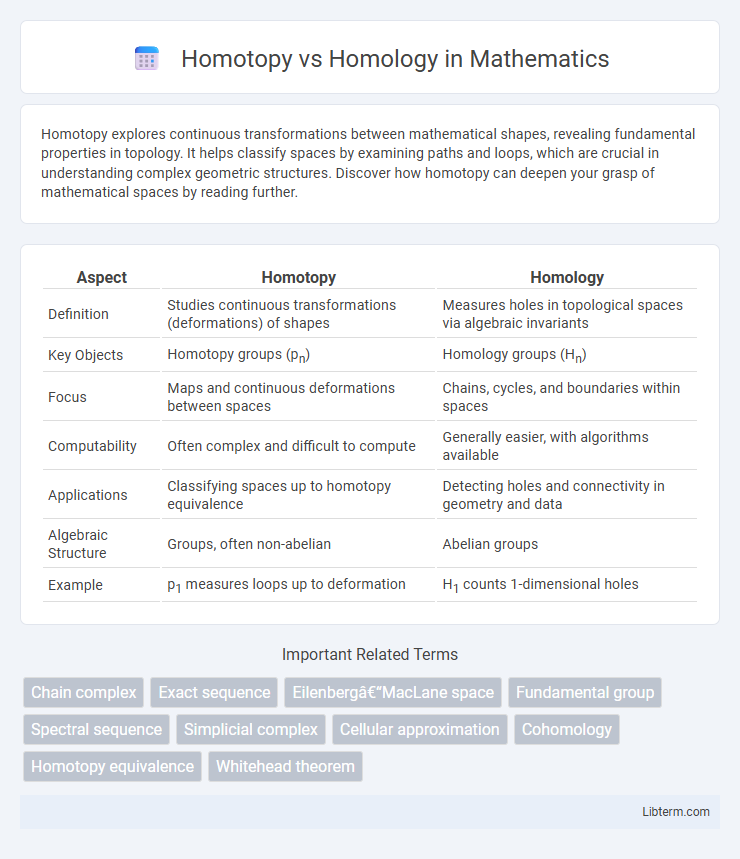Homotopy explores continuous transformations between mathematical shapes, revealing fundamental properties in topology. It helps classify spaces by examining paths and loops, which are crucial in understanding complex geometric structures. Discover how homotopy can deepen your grasp of mathematical spaces by reading further.
Table of Comparison
| Aspect | Homotopy | Homology |
|---|---|---|
| Definition | Studies continuous transformations (deformations) of shapes | Measures holes in topological spaces via algebraic invariants |
| Key Objects | Homotopy groups (pn) | Homology groups (Hn) |
| Focus | Maps and continuous deformations between spaces | Chains, cycles, and boundaries within spaces |
| Computability | Often complex and difficult to compute | Generally easier, with algorithms available |
| Applications | Classifying spaces up to homotopy equivalence | Detecting holes and connectivity in geometry and data |
| Algebraic Structure | Groups, often non-abelian | Abelian groups |
| Example | p1 measures loops up to deformation | H1 counts 1-dimensional holes |
Introduction to Homotopy and Homology
Homotopy studies continuous deformations between topological spaces or maps, capturing the intrinsic shape by classifying spaces up to homotopy equivalence. Homology provides algebraic invariants through chains, cycles, and boundaries, quantifying holes in different dimensions within a space. Both concepts are fundamental in algebraic topology, with homotopy focusing on path and loop structures, while homology measures global topological features.
Fundamental Concepts in Algebraic Topology
Homotopy studies continuous deformations between maps, classifying spaces by their shape-preserving transformations, while homology captures topological features through algebraic invariants revealing holes of different dimensions. The fundamental group, a key homotopy invariant, encodes loops up to homotopy, contrasting with homology groups derived from chain complexes reflecting cycles and boundaries. Both concepts provide complementary tools for understanding topological spaces' structure, with homotopy focusing on deformability and homology emphasizing connectivity and voids.
What is Homotopy?
Homotopy is a fundamental concept in algebraic topology that studies continuous deformations between two continuous functions or spaces, capturing their essential shape features. It classifies topological spaces based on the equivalence of paths, loops, and mappings up to continuous transformations, which helps in understanding their structural properties. Homotopy groups, especially the fundamental group, reveal the nature of holes and connectivity in spaces, contrasting with homology's focus on cycles and boundaries.
What is Homology?
Homology is a mathematical concept in algebraic topology that studies and classifies topological spaces based on their cycles and boundaries, capturing the structure of holes in different dimensions. It assigns groups, called homology groups, to a space, which algebraically represent features like connected components, loops, and voids. Homology provides computable invariants that distinguish spaces by quantifying these n-dimensional holes, making it fundamental for analyzing topological and geometric properties.
Key Differences Between Homotopy and Homology
Homotopy and homology are fundamental concepts in algebraic topology used to classify topological spaces, with homotopy focusing on continuous deformations of maps between spaces and homology concentrating on the detection of holes using algebraic invariants. Key differences include that homotopy groups, such as the fundamental group p1, capture information about loop structures and higher-dimensional analogs, while homology groups provide abelian group invariants that quantify holes regardless of their specific shape. Homotopy is generally more sensitive and complex, dealing with equivalence classes of maps up to deformation, whereas homology offers computable algebraic summaries, making it widely used for practical classification of topological features.
Applications of Homotopy in Mathematics and Science
Homotopy theory provides powerful tools for classifying topological spaces up to continuous deformation, crucial in areas such as algebraic topology and differential geometry. It enables the study of fundamental groups and higher homotopy groups, informing fields like quantum field theory and string theory by analyzing shapes of solution spaces. Homotopy methods also facilitate robotics and computer vision applications through path planning and shape recognition problems.
Practical Uses of Homology in Topological Studies
Homology provides a powerful tool for detecting and classifying holes of various dimensions in topological spaces, making it essential in fields like data analysis, shape recognition, and sensor network coverage. Unlike homotopy, which deals with continuous deformations of spaces, homology offers computable algebraic invariants that are widely used in persistent homology for analyzing the underlying structure of complex datasets. Its practical applications extend to medical imaging, robotics path planning, and material science, where understanding connectivity and voids is crucial.
Computational Methods for Homotopy and Homology
Computational methods for homology leverage algorithms like persistent homology and simplicial complex reduction to efficiently compute topological invariants in high-dimensional data. In contrast, computational approaches for homotopy involve sophisticated techniques such as spectral sequences, obstruction theory, and discrete Morse theory to approximate homotopy groups and classify homotopy types. Advances in software tools like GUDHI, Dionysus, and HAP enable practical computation of homology, while homotopy computation remains more challenging due to its higher algebraic complexity and less-developed algorithmic frameworks.
Homotopy vs Homology: Strengths and Limitations
Homotopy provides a powerful tool for classifying spaces based on continuous deformations, capturing finer topological information such as the fundamental group and higher homotopy groups, which are essential in distinguishing spaces up to homotopy equivalence. Homology, while generally easier to compute and more algebraically tractable, offers a coarser but effective classification by measuring holes of various dimensions using cycles and boundaries, making it suitable for applications in algebraic topology and data analysis. The primary limitation of homotopy lies in computational complexity and subtlety of higher homotopy groups, whereas homology's limitation is its inability to detect certain topological features that homotopy can, such as torsion in fundamental groups or non-abelian structures.
Conclusion: Choosing Between Homotopy and Homology
Choosing between homotopy and homology depends on the complexity of the topological space and the desired level of algebraic detail. Homotopy groups capture finer structural information about spaces, including higher-dimensional holes and deformation classes, while homology groups provide a computable, abelianized summary useful for detecting basic topological features. For practical applications in algebraic topology, homology is preferred for efficiently distinguishing spaces, whereas homotopy is essential for a deeper, more nuanced understanding of topological invariants.
Homotopy Infographic

 libterm.com
libterm.com